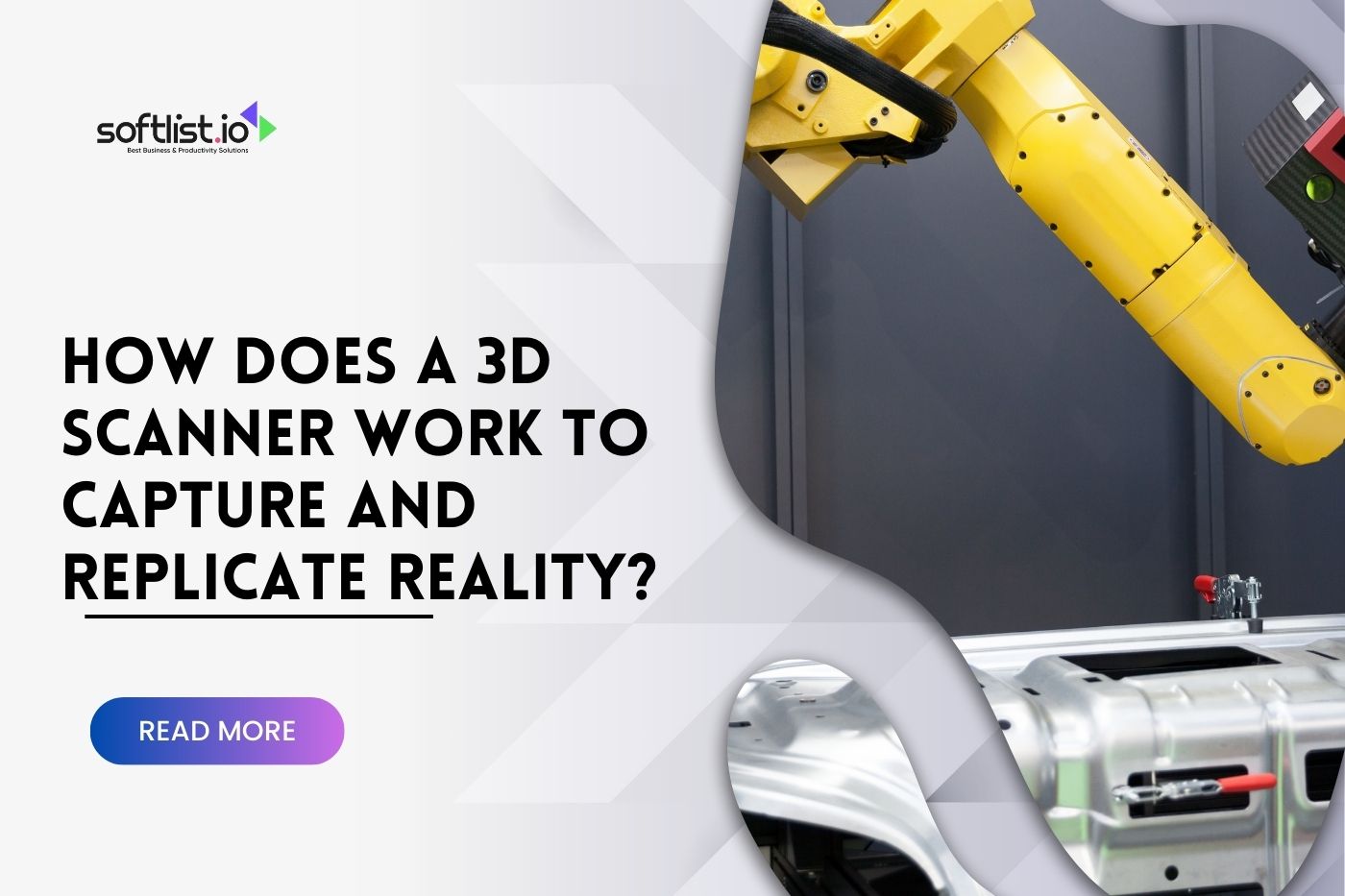Ever wondered how those cool 3D models are made? Well, it’s all thanks to 3D scanning. But understanding it can feel like trying to solve a tricky puzzle. There are many different types of 3D scanners, like lasers and fancy lights, which can make things even more confusing.
So, we’ll make it all simple. We’ll explain how 3D scanning works in easy terms so you can understand it without any hassle. By the end, you’ll be a pro at understanding the magic behind 3D scanning. Let’s jump in and explore.
What is 3D Scanning and How Does it Work?
3D scanning is a technology that captures the shape of an object or environment in three dimensions. It works by projecting a light source, like a laser or structured light, onto the object and measuring how that light changes when it bounces back or distorts.
This information helps to calculate the distance and shape of various points on the object’s surface. The scanner collects these points to create a digital three-dimensional model, called a point cloud, which can be used for various applications, such as designing, manufacturing, or analyzing in detail.
Essentially, 3D scanning is like taking a 3D photograph that captures an object’s dimensions and contours instead of just its appearance.
Different Types of 3D Scanners and Technologies
Source: Canva Pro
3D Laser Scanning
With 3D laser scanning, the scanner shoots laser beams at the object. When these beams bounce back, the scanner measures how long it took for the return. This tells the 3D laser scanner the distance of different object parts, creating a 3D map of its surface.
Photogrammetry
Photogrammetry uses regular photos taken from different angles around the object. The scanning software then examines these photos to determine where surfaces are in space, piecing together a 3D model. It’s like solving a puzzle using pictures.
Contact-Based 3D Scanning Technology
Here, a probe physically touches the object to gather data on its shape. This method requires the object to be stationary while the probe systematically covers the surface of the object.
Contact scanners can accurately scan almost any material, including transparent and reflective surfaces, making them perfect for quality control in manufacturing.
Laser Phase-Shift 3D Scanners
Similar to pulse-based scanners but with enhanced accuracy, phase-shift scanners modulate the power of the laser beam and compare the phase of the laser sent out and returned.
This method is quieter and more precise, ideal for medium-range distances but not as suited for the longest ranges as pulse-based systems.
Structured Light Scanning
Structured light scanning projects a light pattern, like lines or dots, onto the object. By observing how this pattern bends or distorts the object’s surfaces, the scanner can determine the 3D shape.
It’s akin to casting shadows and watching how they stretch or squeeze to understand the shape of what’s casting them.
Laser Pulse-Based 3D Scanning Technology (Time-of-Flight)
These scanners calculate the distance to an object by measuring the time it takes for a laser pulse to bounce back to the sensor. Suitable for long distances, pulse-based scanners are excellent for large objects and expansive areas, able to capture vast spaces quickly.
Laser Triangulation
This method uses a laser beam projected onto an object. A camera or sensor, positioned at a known distance, observes the laser’s reflection on the object’s surface. By calculating the angles of reflection, it can determine the shape and size of the object in detail.
This technology is versatile, used in handheld, arm-based, or tripod-mounted scanners, ideal for scanning objects with challenging surfaces.
The Process of 3D Scanning
Source: Canva Pro
The process of 3D scanning involves converting the physical attributes of an object or environment into a digital 3D model.
This process can be broadly outlined in several steps, regardless of the specific type of 3D scanner being used:
- Preparation: Depending on the object and the type of scanner, some preparation might be necessary. For instance, if the object is too shiny or transparent, it might need a coating to reduce reflection or transparency. Similarly, the environment or setup might need adjustments for optimal scanning conditions.
- Positioning: The object is placed on a platform or within a designated space where the scanner can easily capture all the necessary angles. The scanner might need to be moved around for large or immovable objects instead.
- Scanning: The scanner projects a light source (laser, structured light, etc.) onto the object and captures the reflected light with sensors. This process can involve either a single or multiple passes from different angles, especially for complex shapes requiring detailed capturing.
- Data Capture: The scanner converts the captured light into digital data, creating a point cloud. A point cloud is a collection of data points in space, each representing a tiny part of the object’s surface as captured from a specific angle.
- Processing: The raw point cloud data is processed using software to remove noise (unwanted data not part of the object) and to fill in gaps where data might be missing. This step may also involve aligning and merging data from multiple scans to create a complete model.
- Model Reconstruction: The processed point cloud is then used to reconstruct a 3D model. This involves connecting the dots, so to speak, to form a mesh of polygons (usually triangles) that represent the object’s surface. The resolution and complexity of the model can vary depending on the intended use.
- Post-Processing: In this final step, the 3D model can be refined, optimized, or altered for specific applications. This can include smoothing surfaces, adding textures or colors based on photographs or additional scans, and preparing the model for 3D printing, virtual reality, simulation, or other applications.
The entire process from preparation to post-processing can vary in complexity and duration, depending on the size and complexity of the object being scanned, the type of 3D scanner used, and the desired quality and resolution of the final 3D model.
Post-Processing
Post-processing in the context of 3D scanning is a crucial step where the raw, digitized data collected during the scanning process is refined and transformed into a usable 3D model.
This stage involves several key activities:
- Data Cleaning: The initial point cloud or mesh generated from the scan often includes noise or irrelevant data, such as points that represent background objects or artifacts introduced by the scanning process. The first step is to clean up this data by removing these inaccuracies.
- Data Alignment and Merging: If the object was scanned from multiple angles or with different scans to capture all sides, these different data sets need to be aligned and merged into a single coherent model. This requires precise adjustment to ensure all parts of the model fit together seamlessly.
- Hole Filling and Repair: Scanning might not capture every part of an object’s surface, especially in areas that are difficult to reach or reflect poorly. Post-processing software can interpolate the missing information based on the surrounding data to fill in gaps, though this might require manual intervention for complex features.
- Smoothing and Refinement: The raw scan might have a jagged or rough surface due to the discrete nature of the scanning process. Smoothing algorithms can be applied to create a more visually appealing and accurate representation of the object. However, it’s essential to balance smoothing with the preservation of true surface details, especially for objects with fine features.
- Remeshing: This involves adjusting the mesh structure of the model, either to reduce the number of polygons for simpler, more efficient files or to create a more uniform distribution of polygons across the surface. This step is particularly important for models intended for simulation or 3D printing.
- UV Mapping and Texturing: For applications that require a visual representation of the object’s surface, UV mapping assigns a 2D image (texture) to the 3D model, allowing for detailed colors and patterns to be accurately represented on the model’s surface.
- Optimization for Final Use: Depending on how the 3D model will be used—whether for animation, simulation, 3D printing, or another application—additional optimizations may be necessary. For example, models for 3D printing might need to be made solid, while models for animation might be rigged with a skeletal structure.
How Long Does the 3D Scanning Process Take?
The duration of the 3D scanning process can vary widely depending on the size and complexity of the object being scanned, the type of scanner used, and the level of detail required in the final model.
Scanning can be quick for small and simple objects, taking only a few minutes with modern scanners. However, for larger objects or environments, the scanning process can extend to several hours or even days, especially if multiple scans from different angles are needed to capture all details.
Additionally, the post-processing stage can significantly add to the overall time, ranging from a few hours for basic clean-up and assembly to several days for detailed editing and optimization for specific applications.
In summary, while a basic scan can be completed relatively quickly, the entire process from preparation to obtaining a finished, usable 3D model can take anywhere from a few hours to several days.
Difference Between Resolution and Accuracy
Source: Canva Pro
In 3D scanning, “resolution” and “accuracy” are two important but distinct concepts that often get confused. Understanding the difference between them is crucial for evaluating a scanner’s performance and ensuring the quality of the final 3D model.
- Resolution is the smallest distance between two distinguishable points in a 3D scan. It’s like the detail level in an image; higher resolution means more detail and a denser point cloud, resulting in a more detailed 3D model. Resolution can depend on the scanner’s technology and settings during the scanning process.
- Accuracy, on the other hand, is about how close the measurements of the 3D scan are to the real-world dimensions of the object being scanned. It’s the degree to which the scan reflects the object’s true size, shape, and details. Higher accuracy means the 3D model will more precisely match the physical object.
Final Thoughts
Learning how 3D scanners work gives us a cool peek into how technology can make precise 3D models. Seeing how this tech can be used in many areas, such as making things and even helping in healthcare is amazing.
If you’re interested in knowing more about how 3D scanning works with printing services, check out our articles about printing services. They can show you how 3D scanning and printing work together to make cool stuff.
So, dive into these articles and discover how to use this awesome technology for your projects!
Frequently Asked Questions
Can 3D scanning make it possible to digitally preserve historical artifacts? How?
Yes, 3D scanning can make it possible to digitally preserve historical artifacts. By collecting detailed scan data of an artifact’s geometry and dimensions, 3D scanners can create a digital replica that can be studied, shared, and even replicated through 3D printing without risking damage to the original artifact.
Can I use a 3D scanner with my smartphone?
Yes, there are apps and attachments that allow smartphones to function as basic 3D scanners, using the phone’s camera and photogrammetry software to create 3D models from photographs.
In what ways can scan data from 3D scanners be used for reverse engineering?
Scanning data from 3D scanners is essential for reverse engineering because it provides a digital three-dimensional representation of an object. Engineers can use this data to understand the object’s geometry and design features, making it possible to recreate or improve upon the original design digitally.
Can 3D scanners capture the inside of objects?
Standard 3D scanners cannot capture the inside of objects unless the object is transparent or partially open. However, technologies like X-ray computed tomography (CT) scanners can create 3D models of both the outside and inside of objects.
Can 3D scanners capture colors?
Some 3D scanners are equipped with cameras that capture the colors of the object as well as its shape. This is particularly useful for applications in digital archiving, virtual reality, and online retail.







